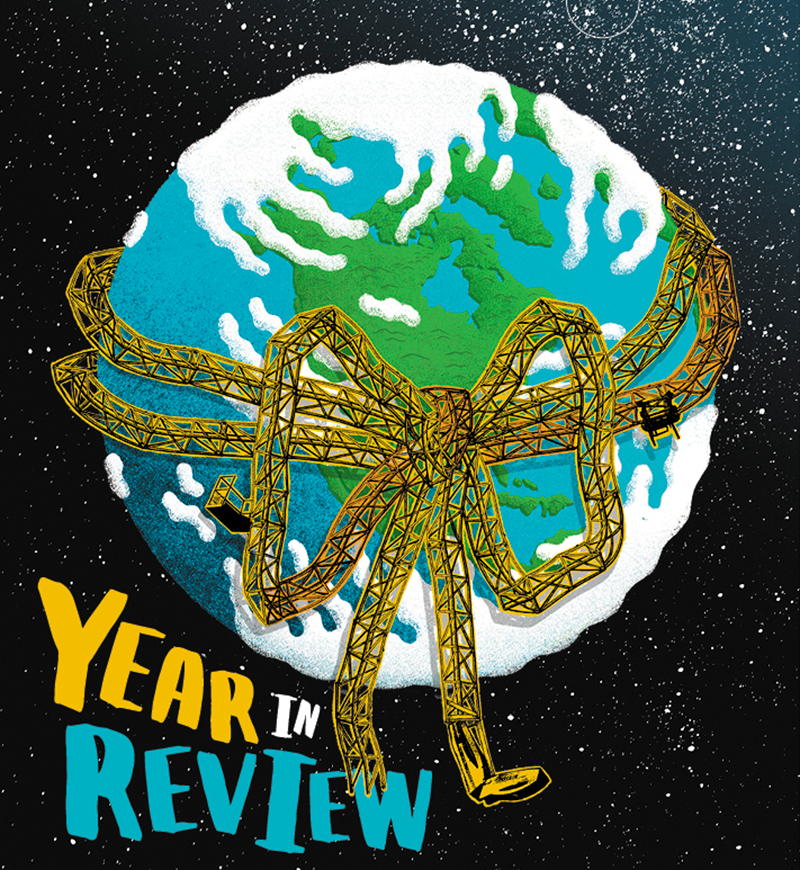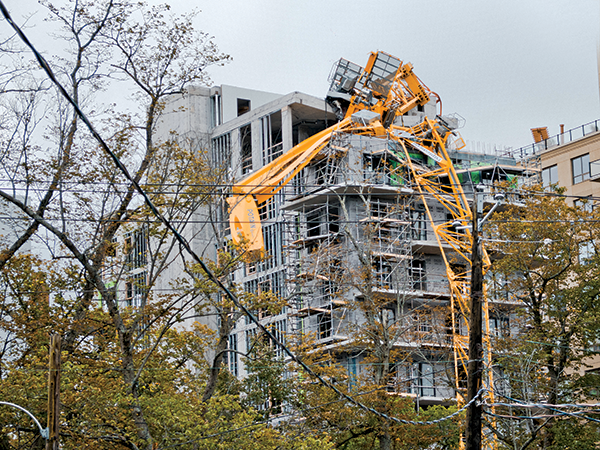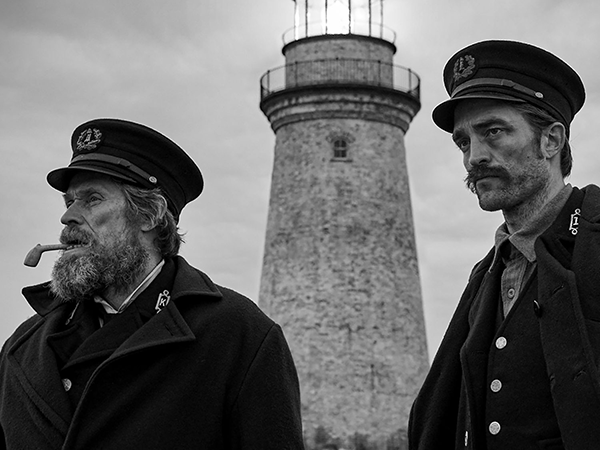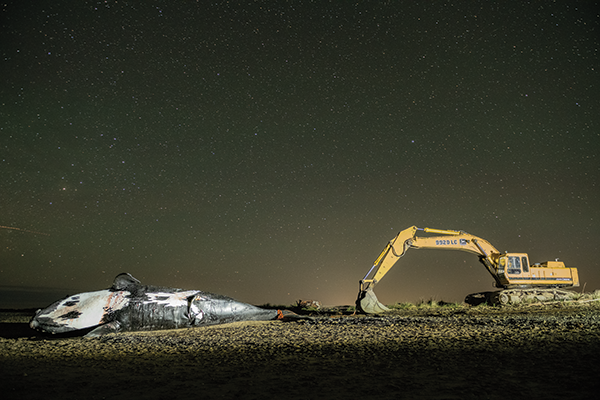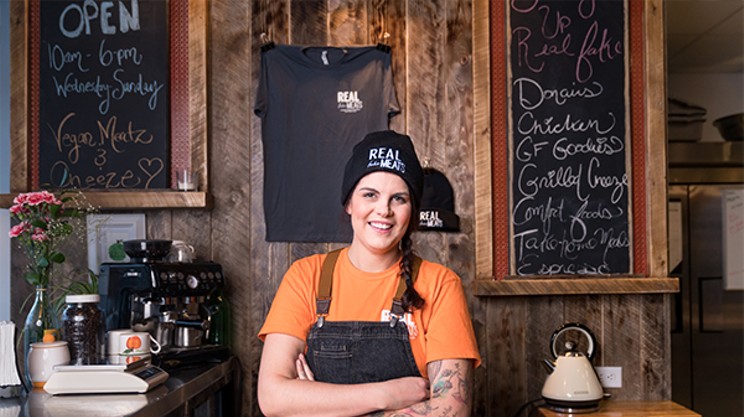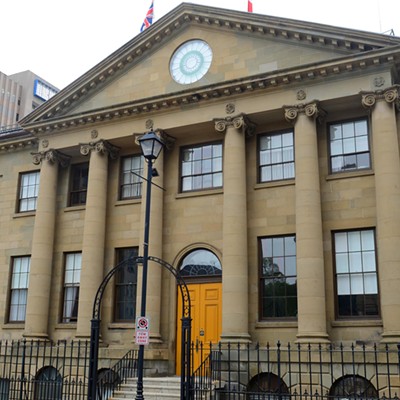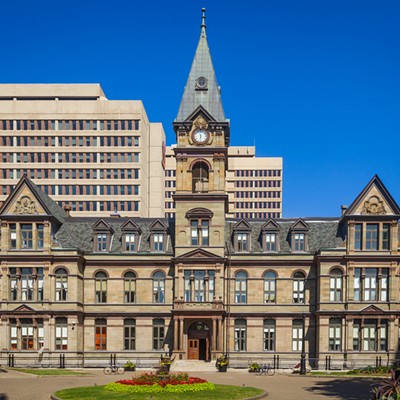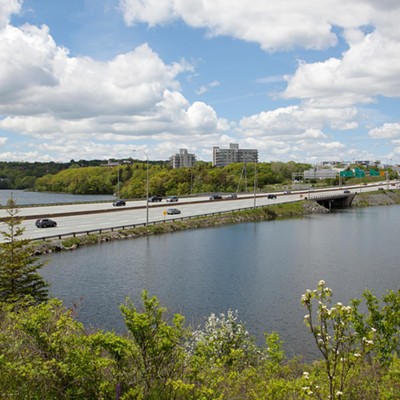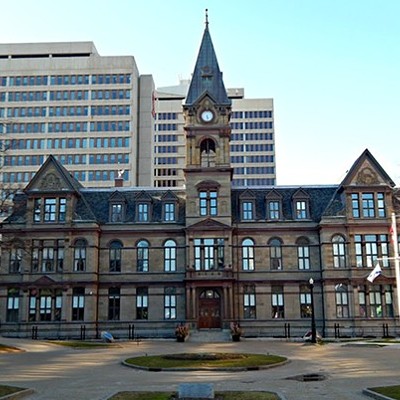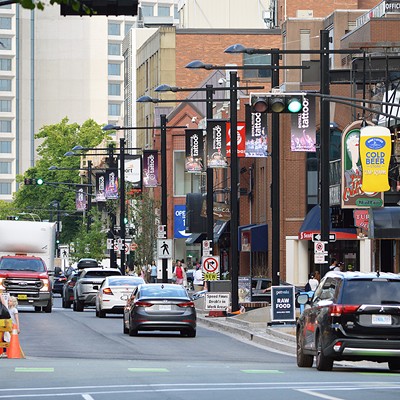Dorian and the crane
Even before it arrived in Halifax and knocked over that construction crane, Hurricane Dorian made a major visual impact. This was the Category 5 storm that stalled over the Bahamas for a day—huge and strong and ferocious on the weather map—killing at least 70 people. Dorian also lead to #SharpieGate, a Cat 5 public relations storm in the United States, after a certain tweeter-in-chief made his own addition to a picture of the hurricane's predicted path. However, it is arguably the image of the crane, cascading like silk over an under-construction apartment building, that best encapsulates Dorian.
Humans can be remarkably resistant to the signs right in front of our faces. Dorian's unprecedented behaviour could be seen as a vital alert about the increasing dangers of capitalism-fuelled global heating. Or we can just ignore that conversation and talk about how living in "hurricane alley" comes with known risks. An anti-science president's unruly ravings: maybe a call for help, more likely something we can shrug off because politicians come and go depending on the will of the people. But a crane collapsing?! That is a rebuke to capitalism itself.
Cranes show construction, growth and progress. Find a crane and you've found the power of money in action, turning raw materials into towering monuments to humanity's ingenuity and drive, all gleaming glass and granite countertops, pocket doors and French doors and patio doors with a master ensuite. So complete is our mastery of nature that we've even stolen a bird's name for it.
The crane is a visible manifestation of the market's invisible hand, guiding capital where it's destined to go. And it's designed to give the middle finger to the natural world, not receive a knockout punch from some overgrown rainstorm with a human name. This just wasn't supposed to happen.
Figuring out exactly why it happened—and thus who has to pay for the damage to the building, and losses for the surrounding businesses, and clean-up costs—is going to take years. The province inspects cranes and issues permits; its investigation of the accident isn't finished yet, so the arguing over its findings haven't even started. Among the few certainties is that a lot of money will be flowing to lawyers. And we'll long remember the sight of the crane's downfall, its bright metal skeleton garishly draped over a drab cement shell, either a great Instagram post or caution tape giving its warning.
Vacancy rates screwed us all
Well, maybe not the Airbnb hosts. Just the lowly renters who scoured Kijiji every hour on the hour, bartered with landlords who jacked rent prices after realizing how popular their listings were and waited with bated breath to just be ghosted again and again before finally settling for a place that was too small/too shitty/too far away/too expensive. Because they didn't have a choice.The abysmal state of the rental market was undeniably one of the city's top stories of 2019. This year continued in the shadow of 2018's record-low 1.6 percent vacancy rate, a stat that had many fingers pointed directly at the growing short-term rental market. Inspired by seeing tenants scramble, The Coast ran its own anonymous renters' survey, collecting horror stories from over 500 people, but it was a report from the Urban Politics and Governance research group at McGill University's School of Urban Planning (UPGo) that served some of the rudest awakenings.
In 2019, HRM boasted 2,420 short-term rentals—the most in Atlantic Canada. The 1,980 of them located in the city made a whopping $30.9 million. But how do those numbers affect us renters? Well, according to the UPGo report, this removed 740 units from the long-term housing market (see: scrambling renters, rising prices). And how's this for a mic drop moment? If those commercial short-term rentals were to be returned into the long-term housing market, the vacancy rate would rise from that very sad 1.6 to 2.8 percent (and FYI UPGo says the ideal is three percent). The report says it would also eventually bring rent prices back down to earth.
Municipal and provincial governments aren't blind to these numbers and the problems associated with them: HRM and the province both launched surveys on short-term rentals in November and are considering what regulating the STR market looks like. Whether there'll be a new lease on leasing life is a question for the next decade.
Puff, puff, pass the legislation
If you live under a rock perhaps you've missed the teen craze that caught on harder than Garage tank tops with lace on the bottom: Vaping. Sleek USB-style vaping pens are the hot, newer version of a more traditional, albeit clunkier, tool that often helped folks quit smoking. Wildly popular among teens and on TikTok, the vapour that gets smoked in vape pens is sold in different packaging, with different levels of nicotine and flavours ranging from bubblegum to winter moss. The provincial government announced that by April 1, 2020 it would be illegal to sell the flavoured vapour product unless it was cigarette or bland flavoured, the new idea is to curb young users.
Slowing down journalism's slide
There hasn't been a lot of good news in the media industry this decade, and 2019 had more of the same newspaper closures and radio station sign-offs and website shut-downs. But in a small bright spot, the story of media's troubles finally got reframed. The ongoing upheavals of the information landscape are not simply traditional old media versus inevitable new media, or dinosaur legacy publishers struggling to deny the nimble superiority of tech upstarts. This year it became clear the fight is actually between expensive, rigorous, accountable journalism and cheap, questionable, algorithm-guided content. And the stakes include the future of truth and democracy itself.As Facebook and Google continued to strengthen their monopoly on the world's advertising and attention—suffocating all other media, new or not—governments started responding. In the US, Facebook got a $5-billion fine for privacy violations. Europe brought in its GDPR (General Data Protection Regulation) to give citizens more rights around their digital selves. Australia tasked Google and Facebook with developing a code of conduct to fight fake news. Canada announced $600 million to help media outlets over the next five years.
Global policy and local reality aren't necessarily in sync. SaltWire Network—the company the Chronicle Herald formed in 2017 when it bought a couple of dozen Atlantic Canadian newspapers from TC Transcontinental—is the biggest publisher in the region, and in April it threw its whole existence into doubt when it announced a lawsuit against Transcon related to the acquisition. This week, Toronto Star parent TorStar is shutting down its StarMetro chain of free dailies, including the Halifax version. Can government efforts to turn around journalism's decline work soon enough for journalists? Time will tell.
Banning bags
The state of California took the climate emergency into its own hands this year, pushing forward with a plan that demands cars have better fuel efficiency than national laws require. Although America's president is working to thwart this declaration of progressive independence, four of the big auto companies have promised to meet California's higher standard. Meanwhile, the government of Nova Scotia decided to show leadership in the environmental crisis by becoming the third province to eliminate single-use plastic carriers. The bag-ban bill passed into law in October, giving companies 12 months to comply. NS-based grocery giant Sobeys won't take that long, however. It's aiming to get rid of plastic bags at its stores across the country by the end of January 2020.
Climate catalysts
Nova Scotian youth were on the front lines in the battle against the climate crisis in 2019.From the onslaught of Hurricane Dorian to rising sea levels and the ever-looming threat of increased health problems and endangered animals, the effects of climate change were felt across the province. However, while much of the government turned a blind eye, young people took matters into their own hands.
Organizations like SchoolStrike4Climate HFX, gathered impassioned youth to strike across the municipality throughout the year, demanding immediate, meaningful action against the climate crisis. Other youth-led organizations, like Shake Up the Establishment, worked to bring climate change to the forefront of the 2019 federal election and provide scientific research in a way that was easily accessible to the public.
"Don't just support the youth," says Julia Sampson, one of the co-founders of SchoolStrike4Climate HFX. "We want adults to do something themselves. They have more power than youth in our community and government. Use that power to everyone's advantage."
These youth-led movements arguably carried the battle against climate change, after thousands of youth and adults showed their support through climate strikes, die-ins and events like #BridgeOut. Following the IPCC report in October stating that we have only 12 years left to prevent a climate catastrophe, thousands of Haligonians banded together to participate in the K'jipuktuk- Halifax Week of Climate Action. This event was designed to not only bring awareness to the dangers of the climate crisis but to demand the government change its policies and the public to vote for climate.
Youth-led groups like the Supernatural Design Collective pushed for more education on green spaces while Clean Foundation provided green internships which gave youth like Daniel Robinson an opportunity to learn about sustainability and become an environmental leader. These organizations focused their activism on education that would impact future generations.
Other youths enforced their activism through the law itself. Ira Reinhart-Smith and 14 other kids and teens filed a lawsuit against the federal government for putting their lives at risk by not addressing the dangers of climate change. "This is the biggest threat that humanity has ever faced," says Ira Reinhart-Smith. "We're not just some kids who have nothing better to do with our time so we're just trying to strike. What we're doing is trying to save our world, and we shouldn't have to be doing this."
Despite a lack of government action throughout the year, it appears the green movement has gained ground on a municipal level. The first of the HRM 2020/2021 budget discussions showed that the kids have made a difference. Mayor Mike Savage summed up the future of finances in HRM by stating that in order to make a commitment to fighting climate change, it's going to take real money.
On a federal level, youth dominated political discussions during the 2019 election, encouraging most parties to make climate a part of their platform and outnumbering the baby boomers for the first time.
Next year will be a year full of decisions that will not only affect this generation but the potential for future ones. Without political action, the climate crisis will come into full effect in 2031. While 2019 had the potential to be a hopeless year, our youth soldiered on. It's time that politicians and corporations follow suit.
—Isabel Buckmaster
Halifax catches Wanderers fever
Halifax historically has a reputation of being a hockey city thanks to the Halifax Mooseheads. And in early spring, it morphs into a basketball town when hosting the Atlantic University Sport and U Sports Final 8 basketball tournaments. So really, is it a surprise that the city naturally became a soccer town over the summer?The Canadian Premier League brought professional soccer to Halifax in the form of the HFX Wanderers and it was truly love at first sight. The Wanderers won their first-ever home game with a thrilling late goal, prompting the rowdy supporters section known as "The Kitchen" to light blue smoke bombs and get rowdy. The team finished last in the standings, but you'd never know if you went to games at Wanderers Grounds, as the team only lost twice to one team during the entire CPL season. The team filled a sports void in the summer, and the exciting atmosphere was enough to win over soccer lifers and those who watched the beautiful game for the first time. While footie fans can be a fickle bunch, the Wanderers supporters group Privateers 1882 put in the work to make sure anyone could feel welcome and cheer on the team.
Hockey town, basketball town, soccer town—is there room for another sport? With professional lacrosse team Halifax Thunderbirds kicking off their inaugural season with a 12-4 victory at their home opener this month, time will tell if a city that embraces lots of sports can handle even more athletic thrills.
—Jonathan Briggins
Halifax gets dragged
While local drag queens have long been at werk building a scene in Halifax, 2019 saw an explosion of international divas come through, including Ru Paul's Drag Race stars like A'Keria C. Davenport, Aquaria, Manila Luzon, Naomi Smalls, Vanessa Vanjie Mateo and Latrice Royale, to name a few—cementing our city's spot on the touring drag circuit.Bus ads around HRM celebrating the October show by Trixie Mattel (pictured)—who Fast Company called the biggest player in the drag world, "doing things no one has ever done—not even RuPaul"—demonstrate the city's appetite for campy excess is ravenous. Here's hoping the trend doesn't sashay away anytime soon.
Mooseheads host the Memorial Cup
The Halifax Mooseheads hosted the crown of junior hockey, the Memorial Cup, in May. The prestigious tournament brings together the winners of each of the three leagues that make up the Canadian Hockey League along with the host.The last time the city hosted the tournament, back in 2000, many of the players on the team weren't born—or at least weren't old enough to talk or skate. This time, the party atmosphere spilled onto the streets, with free pre-game concerts on Argyle including Sloan and Ria Mae for both puck lovers and the sports averse.
The Moose couldn't get past the Rouyn-Noranda Huskies in the final, jumping out to a 2-0 lead but losing 4-2. Despite coming up just short, Halifax hockey fans were treated to the best junior hockey not just in the tournament, but all season leading up to the final event.
—Jonathan Briggins
Glen Assoun gets justice
On March 1, after spending nearly two decades in prison for the murder of his former girlfriend, Brenda Way—a crime he didn't commit—Halifax's Glen Assoun was finally exonerated. But it wasn't until July, after a legal battle with local journalists (including Halifax Examiner's Tim Bousquet, who has followed this story tirelessly) that court documents detailing exactly why were unsealed. A press release from Innocence Canada in July said: "Recent court submissions suggest that authorities colluded to suppress vital evidence. The documents may also point a finger at the real perpetrator—or perpetrators—of Ms. Way's murder." By September, the federal and provincial government had paid Assoun an initial installment of compensation for the unfathomable wrongdoing, but details on further payment and a public apology are still a mystery.
Halifax's stadium dream doesn't die
Sung to the tune of "The Hockey Song," with apologies to Stompin' Tom Connors.
Hello out there. We're on the air. It's football night tonight.
Tension has grown, whistles blown, and proposals on thin ice.
Council jumps, big players bump and the city goes insane.
Someone roars "not on Shannon Park's shore" at the good ol' stadium game.
The quickest $20 million in the game, the good ol' stadium game.
City staffers dash, urban and rural councillors clash, affordable housing plans trail behind.
Schooners catches some wind, then makes its bid, even survives an attempt to do it in.
Big-city dreamin', small-city screamin', maybe it'll all go up in flames.
Another year, more football sized-tears, the big-boy dream won't die.
Oh the good ol' stadium game, the inevitable shame you can't tame
The quickest $20 million in the game, the good ol' stadium game.
Atlantic Canada's first overdose prevention site
As Canada's opioid crisis deepens, almost 14,000 Canadians have died from opioid-related death since 2016. The increase of fentanyl in the drug supply is putting many users in danger, and a Canadian-grown strategy for curbing that risk finally made it to the east coast this year—with no help from local governments.Through local organizing and fundraising HaliFIX Overdose Prevention Site Society opened Atlantic Canada's first federally-exempted overdose prevention site this September. The site, located in the same building as Direction 180, has had 50 visits from Haligonians looking for a safe space to use their substances.
One of the founders of the space, Matt Bonn, told The Coast in April "We have to keep in mind that the most suffering person is the person who's still using unsafely. Their lives are at risk immediately, right now, and we have to give them a life-saving service."
Just this year, there have been 43 confirmed overdose deaths in Nova Scotia, and in recent years, around five deaths a year have happened in HRM. While the province still hasn't made any decisions around safe consumption sites, HRM just approved the first steps towards creating a municipal drug strategy that would see the municipality playing a leadership role in supporting essential health-care services that improve the safety and well-being of people living with addiction and substance use in Halifax.
Canada's missing and murdered Indigenous women and girls get big report, little action
After two-and-a-half years, the National Inquiry into Missing and Murdered Indigenous Women and Girls released its final report on June 3 this year, laying out the role that all levels of Canadian government play in the race-and-gender-based genocide that is facing, and has long faced Indigenous and Inuit women.The report found that Indigenous women are 16 times more likely to be murdered or missing than white women. Nova Scotia Native Women's Association president Lorraine Whitman told The Coast in June that "it truly is a genocide. This is a cultural genocide, one that is added up and accumulated over the years."
The report described the persistent and deliberate pattern of systemic racial and gendered human-rights violations and abuses in the past and maintained today by the Canadian state. These abuses, which are designed to displace Indigenous peoples from their land, social structures and governance and to deny their existence as Nations, communities, families and individuals have caused the disappearances, murders, and violence experienced by Indigenous women and people.
The report called for immediate legal and social changes to systemic violence against Indigenous women, girls and 2SLGBTQQIA people and Whitman urged non-Indigenous Canadians to never forget the families who have been telling these stories for decades, and those who have been re-traumatized through the process of the national inquiry, for the betterment of Canadian society.
There has yet to be any concrete action from local government in light of this report—and instances of violence against Indigenous women continue to rise.
The year in film
In 2019, with memories of the film tax credit cuts still in mind, it feels the industry has stopped waiting for the government to hurry up and #SaveNSFilmJobs and is rescuing itself. The most obvious example of the continual come-up? Oscar-bait thriller The Lighthouse, which both cemented director Robert Eggers as a titan of the new art-house horror (Rolling Stone listed the flick, which was shot between Cape Forchu, Yarmouth and Burnside, as the seventh best horror movie of the year) and saw the full-fledged return of major Hollywood projects to the province.Matt Likely, production designer on the movie, told The Coast in September that "the prospect of working on a major Hollywood picture like this felt like a thing of the past. We lost a lot of crew to other places—mostly Toronto. We had a rough couple of years. It's scary when a big movie like this comes along because we want to make a good impression," he added, saying a success like The Lighthouse "builds our momentum—helps build our case" as a movie-making destination province.
Other big-name movies shot in Halifax opened this month at film festivals. Stage Mother, directed by Thom Fitzgerald, had its world premiere at the Palm Springs Film Festival in early December, while the Chelsea Peretti-starring Spinster debuted at the Whistler Film Festival.
Meanwhile, the indie side of the industry is seeing success stories of its own. Dartmouth-based director Heather Young kicked off this year's FIN Atlantic International Film Festival after debuting her first full-length offering at the Toronto International Film Festival. As she told The Coast in September about her process, Young wants to make movies about "a real person, that feels like someone I could meet in my real life—that both looks like and sounds like someone I could meet in Dartmouth, Nova Scotia." Clearly, she's not the only one.
A tumultuous day in the neighbourhood
If a city is a living organism, lungs and neighbourhoods expanding and collapsing with gulps of air, it makes sense that streetscapes, like arteries, will forever pump with change. The differences felt in 2019 haven't necessarily been ones that started this year, but they have rolled forward with fresh oxygen these past 12 months—particularly through the artists'-hub-under-threat that is the north end.Gottingen Street has long felt like patient zero in the gentrification of the area, and the city-wide scare that its indie theatre outpost The Bus Stop Theatre might close was front-page news this year. Its neighbour, the scrappy DIY collective Radstorm, faced similar challenges: Both organizations want to buy their buildings to make their futures more certain, but both lack the resources.
While The Bus Stop chases funding from the federal government's Department of Heritage and provincial and municipal governments, Radstorm went another route, relying on a crowdfunding campaign and other fundraisers. When The Coast spoke to The Bus Stop's executive director Sébastien Labelle in November, he said it was a "matter of faith in people's positive interest in the project"—and noted later by email that the subject of promising to pony up for the theatre co-op would be back in front of regional council sometime in January.
Labelle described it as a "holding pattern" in terms of funding support, with the province and federal governments both waiting for the city to commit to funding first.
As of print time, Radstorm is currently at $10,584 of its $50,000 goal.
The back half of this decade saw many hits to both the neighbourhood and the smaller end of local venues: The Company House still sports a "for sale" sign in the windows at 2202 Gottingen Street. The Waiting Room Theatre, which housed KAZAN CO-OP and a host of indie, low-budget productions, was flattened for apartments at 6040 Almon Street in 2018. The Living Room Theatre at 2353 Agricola Street was replaced by a doggy daycare.
But there's reason to remain optimistic: The Bus Stop was awarded the inaugural Creative Community Impact Award at November's Creative Nova Scotia Awards Gala. "There's an obvious bittersweetness to this award as we receive it in the midst of a campaign to save our space," Labelle said as he took to the stage to accept the award. Lara Lewis, vice-chair of The Bus Stop's board, chimed in to say she hopes the $10,000 purse "can...bring us one step closer to owning our space."
Meanwhile, the floor above Radstorm at 2177 Gottingen Street is, since November 29, the home of Eyelevel artist collective, with the visual-arts group deciding to remount a physical space after existing for a time as a pop-up gallery.
Neighbourhoods will always change, but this much is certain: Even if the developers aren't done building, the artists aren't done fighting.
Barho family's fire horror
All seven children died. These few words conjure crushing memories of the February tragedy that drew sympathetic grief from neighbours across the city. The province. The country.Originally from Raqqa, a city of 165,000 in Syria, Ebraheim and Kawthar Barho and their kids emigrated to Nova Scotia in 2017. They settled outside the city in Elmsdale and clearly settled in, having another son, moving into Halifax for a bigger pool of opportunities and making plans for another move. The Barhos were apparently days away from returning to Elmsdale when the fire started in their Spryfield home.
Only mom Kawthar and dad Ebraheim made it out alive. Ebraheim, who went back into the burning house for his kids, was taken to the hospital immediately. The latest report said he was still there, in a medically induced coma and being treated for extensive burns.
"When he wakes up and he finds himself without his children, he will be in big shock," Ebraheim's brother Ali told CBC in July.
It is unimaginable. The only hope is that Ahmed Barho, Rola Barho, Mohamad Barho, Ola Barho, Hala Barho, Rana Barho and Abdullah Barho rest in peace.
Small business goodbyes
Change is hard, especially when it affects your faves. This year, the small-business scene said so long to some longtime Halifax institutions, and to be honest, it stung. First, after 22 years as downtown's intimate watering hole, prime real estate for first dates, quiet conversations and judgement-free solo beers, Tom's Little Havana announced in March that it would ride off into the sunset and rebrand as Sura Lounge. Though the news was a bit of a non-surprise (it moved locations in 2015 and changed ownership in 2017) it was still a punch to the gut of local nostalgics.Next, in July, the 87-year-old Smith's Bakery blamed a leasing issue for the loss of its location and eventual closure; diehard fans have been missing its fresh-baked breads and Hello Dolly squares every day since its sign off in August.
After nearly two decades of slinging antiques and curio from a landmark location on Granville Street, Urban Cottage Antiques & Collectibles recently announced it will sell off its inventory and close its doors before year's end. And, after surviving in the selfie age, the charmingly non-descript Camera Repair Centre on Hunter Street is taking a much-deserved rest after 45 years of grinding, it'll call it a day (forever) before the end of 2019.
Craft beer continues to go off
Those who like the indie beer scene in Nova Scotia still like it a lot—the NSLC's year-end results in June showed that craft beer sales were up 27.3 percent (to about $16.7 million) and cider/ready-to-drink sales had jumped 80.9 percent in the past fiscal year. And that passion for local-made pints was hammered home with the beer year in brewery news.Twenty nineteen saw the arrival of Propeller Brewing Company's arcade/bar hybrid on Gottingen Street (and the news it would open a Quinpool location in 2020), North Brewing Company's pastel beauty of a brewery and taproom in Cole Harbour, Garrison Brewing Company's blockbuster Oxford Taproom on Quinpool Road and the classically cool Stillwell Freehouse on Agricola Street—and the crowds went wild! Luckily, NS Beer Memes reminded everyone to keep their egos in check by dishing out a steady waterfall of playfully sick burns via Instagram.
The most recent brewery news comes from Nine Locks Brewing Company, which announced it would move to a brand new to-be-built brewery space on Prince Albert Road next year. Word of that expansion came after the brewery opted not to change or apologize for the "cheeky" marketing of its Dirty Blonde—despite complaints from the public, the service industry and 40 members of the Craft Brewers Association of Nova Scotia—pleading the "it was never our intention to insult anyone" defence against accusations of misogyny in an article by CBC.
Accused rapist dies, is celebrated for his leadership
In November, Gerald Regan—the former Nova Scotia premier and MP who dodged charges of over 30 counts of sexual misconduct from 30 women (some as young as 14)—died at the age of 91. Premier Stephen McNeil and MP Elizabeth May were among the prominent voices to glowingly tweet about Regan's legacy while women across the country chose to scream into the void.
NS gets non-binary birth certificates
In July 2019, the provincial government updated the sex identifier field of birth certificates and drivers licences, meaning those who have had their sex misidentified at birth can finally see themselves reflected in their government-issued ID.Options to list a sex indicator as X or leaving the space blank are changes that have been in the works since 2015, with consultations with the transgender community informing the updated ID process. There is no fee to correct a sex indicator with the province and the change is open to all Nova Scotian residents and NS-born applicants.
A plan for the city
It's 2025. There are huge construction projects on every main street. You can't lay naked in your back yard anymore because there's now a tall condo building down the street. There are more apartment units on the market but there are also more people living in the city and your wage is still chronically low so you can't afford a nice place anyways. All of the new buildings look the same, with glassy storefronts and generic bike racks and eight-storey-tall living units shooting up from the building. It all happened so fast. You turn to your friend on a Tuesday and say, 'It's like overnight there was a crane on every corner, I thought these things took forever to get approval.' You furrow your brow in disdain, step in a puddle and slog on. The Centre Plan Package A—part one of HRM's sweeping update to planning bylaws (the rules about what can be built where) snickers: "It was me, I did this."
2019's best album
The cover for Blue Lobelia's Beneath all Bloom features a fairytale-feeling scene of a woman asleep under a canopy of giant wildflowers. The image sticks as a huge scaffolding of song—with violin, cello, drumbeat punctuations and breathy vocals that contain the horsepower of a whole choir—rise stories above your ears. The slightest taste of trad music sits in the back of your mouth, rounded with indie-folk vibes. It's unlike anything else you've listened to this year, a thing of bright beauty in a time that desperately needs it.
Right whales in danger
Twenty-nineteen started with a twinge of hope for the critically endangered North Atlantic right whale. After a year of no births in 2018, researchers who closely monitor the species' dwindling population found seven newborn calves off the coast of Florida and Georgia last winter. By this fall, though, 10 whales had been killed after being struck by large ships, entangled in fishing gear or from other still-unknown causes. The first newborn calf of this year's birthing season was spotted this week, but as in 2017 and 2018, deaths once again outnumbered births this year.Underscoring the loss was the death of Punctuation, a healthy breeding female estimated to be about 40 years old. One of fewer than 100 breeding females left, in June she was found floating in the Gulf of St. Lawrence, her body carved up in staccato lacerations by propeller blades.
The Gulf of St. Lawrence is a relatively new, and especially deadly, habitat for right whales. They've only been seen feeding there since 2015, after their sole source of food—tiny crustaceans called copepods—started disappearing from the Bay of Fundy and Scotian Shelf. The Gulf waters may be rich in food, but they're also heavy with shipping traffic.
And from May to June, when the whales arrive, they're also thick with snow-crab traps and nylon fishing line which whales easily get tangled in.
This November, right whale researchers released their annual Right Whale Report Card, which estimates there are now 409 whales left. That's a 17 percent drop from the population's post-whaling peak of 490 in 2010— despite regulations enacted to slow down ships and close fishing in areas where right whales are seen.
"We need to roll our sleeves up our arms and start hammering out protection measures that do more than the ones are doing now," says the Canadian Whale Institute's Moira Brown. "There is going to be a period of trial and error, but the whales can't really afford any errors."
—Chelsea Murray
No More Warehousing speaks up
Rents are high. Slum lords are greedy. Airbnb is taking units off the market. Population is rising and vacancy rates are at an all-time low. The fight for better and more affordable housing persists.But for a group of activists, the fight for better and more affordable housing goes beyond the cost of rent. No More Warehousing: Nova Scotia Association for Inclusive Homes and Support, People First Nova Scotia and other groups called for better housing options for people living with disabilities this year.
At an event at the Halifax Central Library in March, Vicky Levack spoke about living in a nursing home as her only option, "unless I wanted to live with my parents for the rest of my life," she says. According to the 2016 census, 240 Nova Scotians between 18 and 60 years old are living in nursing homes, often because of a physical disability. Another 600 are institutionalized, or "warehoused"—put in any facility that is out of the way, or inappropriate for their needs—in remote locations across Nova Scotia.
The activists are calling for small options homes, which allow people with a similar level of care to live together and lead independent lives as an alternative to living in facilities.
The province removed the moratorium on building group homes, but activist and author Jen Powley says the eight planned buildings are "only a drop in a very large bucket that is needed" for the more than 1,500 on the waitlist.
The crisis continues for Avalon
"As a province, as a community, how are we going to better provide access to services and support in a long-term basis for all survivors of sexualized violence?" asks Jackie Stevens, executive director of Avalon Sexual Assault Centre, in an April 2019 Coast article.It's a question that still lies unanswered.
The centre's caseload has been on a steady uphill climb since Rehtaeh Parsons' 2013 suicide. But the viral sweep of #MeToo saw the numbers of people requesting services reach a new peak of 443 counselling clients in 2018—its highest number ever. Its team of sexual assault nurse examiners, meanwhile, had a 68 percent increase in responses over 2017.
With wait times stretching out longer than two years, the centre is so overbooked its waitlist went on pause in April—the first time in 23 years it hasn't been able to take new clients. (Sexual assault nurse examiners, professionals who offer medical guidance and evidence collection after a sexual assault occurs, can still be reached through Avalon—as can referrals and information.)
With the surge of incoming cases and government funding that simply isn't keeping up with demand, the centre—which is HRM's only sexual assault centre, one of four in the entire province—is chronically underfunded. Stevens says it's a story being told at crisis centres coast-to-coast.
But some staff are arguing it didn't have to get to this point. In March, Avalon workers began the process of unionization in an attempt to push back against a board they felt was contributing to rape culture by not working as effectively as possible with its employees (the board—which is entirely new and voted in in September, with union certification being completed in July—meanwhile, says it is attempting to restructure in a way that will support the centre's day-to-day functions and overall ethos better. When reached by phone, Stevens says the continued need of a place like Avalon "isn't coming out of the inability or ineffectiveness of organizations. The needs of these services is coming from all the systemic and social issues and decisions around how resources are shared and how programs and services are prioritized.").
As of print time, staff and the board haven't gone to bargaining for unionization, while the waitlist's reopen date is still to be announced.
As Stephanie Domet reported in an August issue of The Coast: "Everyone involved agrees on two additional things: The work Avalon is doing is vital, and it is woefully underfunded."
To speak with a sexual assault nurse examiner at Avalon call (902) 425-0122.

